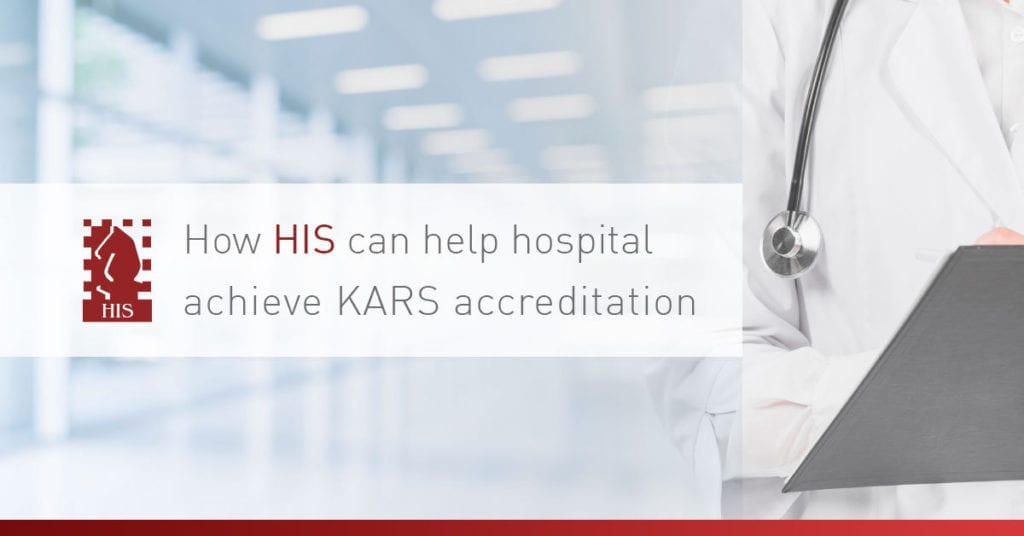Hospital accreditation has been defined as a self-assessment and external peer assessment process used by health care organizations to accurately assess their level of performance in relation to established standards and to implement ways to continuously improve. Critically, accreditation is not just about setting standards: there are analytical, counseling and self-improvement dimensions to the process. There are parallel issues in evidence-based medicine, quality assurance and medical ethics. The reduction of medical error is also a key role of the accreditation process. Hospital accreditation is therefore one component in the maintenance of patient safety.
In Indonesia, the accreditation program was initiated in 1995 by the Commission on Accreditation of Hospitals and Other Health Facilities (KARS – Komisi Akreditasi Rumah Sakit), established by the Ministry of Health. KARS is an independent and non-profit organization that focuses on the Hospital accreditation process, dedicated to elevating patient quality and safety.
KARS’s process is done according to ‘Standar Nasional Akreditasi Rumah Sakit Edisi 1’ (SNARS), which is the standard patient service aimed at improving patient safety and quality of care, with a risk management approach in the hospital. The development of SNARS was based on several references:
- ISQua standard accreditation principles,
- JCI Standard Accreditation 4th and 5th edition,
- Government and professional organization regulations and laws, including national guidelines and referrals applicable to the hospitals nation-wide,
- KARS hospital accreditation standard (2012 edition),
- Study of survey results of the standards and elements that are difficult to meet in hospitals Indonesia.
The first edition of National Hospital Accreditation Standard (SNARS) is effectively applied starting January 1st, 2018 and consists of 5 standards:
- Patient Safety Goals.
- Patient Focused Service Standard:
– Hospital Access and Continuity,
– Patient and Family Rights,
– Patient Assessment,
– Patient Care Service,
– Anesthetic and Surgery Service,
– Drug Use and Pharmaceutical Care Service,
– Education and Communication Management, - Hospital Management Standard:
– Patient Safety and Wellbeing Improvement,
– Infection Prevention and Control,
– Hospital Governance,
– Facility and Safety Management,
– Staff Authority and Competency,
– Information and Medical Records Management. - National Program:
– Reduction of maternal and infant mortality rate,
– Reduction of HIV/AIDS morbidity rate,
– Reduction of tuberculosis morbidity rate,
– Control of antibiotic resistance,
– Geriatric services. - Medical Education and Hospital Service Integration.
With the above standards, how would a Hospital Information System (HIS) contribute to the accreditation process in hospitals?
A good HIS is targeted toward increasing patient care and safety by providing the following features:
1. Communication between Clinicians and Support Care Decisions is Facilitated
A patient’s medical journey often involves the inputs of multiple healthcare professionals in their care. This can dramatically increase the potential for miscommunication or errors. Communication failure is one of the most common factors contributing to adverse events.
Data completeness is an important safety issue in its own right. Opportunities to capture the information are typically discrete. For example, a relevant medical history might only be captured during the initial assessment of a patient. Accurate medication history, details of any allergies and significant comorbidities are obvious examples that have the potential to have a recurring effect on future care decisions. Such information, once captured, should be accessible for all future healthcare encounters and, where care involves multiple providers, should be shared efficiently and securely between providers.
Electronic Patient Records (EPR) underpin the HIS applications. One of the objectives of the EPR is to tackle issues of data completeness. Structured inputs can mandate information recording, while the electronic format minimizes the risk that information is subsequently mislaid. A HIS ensures that key demographic, clinical, physiological, biochemical, and pharmaceutical variables are collected systematically and in a standardized manner for all patients.
A HIS is designed to help reduce errors by compiling and maintaining all of the patient’s health information into one easily accessible record.
2. Medication Errors are Eliminated
Mistakes in prescribing are one of the most common types of medical errors and can potentially be serious, sometimes even leading to the death or disability of the patients. The initial prescription order (decision-calculation) typically carries the greatest risk of serious harm, but mistakes can occur at each stage of the prescribing process:
- Decision errors: failure to account for relevant comorbidities, polypharmacy, previous reactions, incorrect decision;
- Calculation errors: failure to calculate the appropriate dosage;
- Communication errors: dosages written incorrectly, illegible handwriting, wrong patient, ambiguous information on prescriptions, medication not given in a timely fashion;
- Monitoring errors or incorrect length of treatment: failure to track drugs with risk of accumulation of toxicity, or where time-limited treatment is desirable;
- Slips: incorrect drugs or dose packaged at dispensation, drugs given to wrong patient.
Electronic prescribing can help reduce prescription errors by allowing clinicians to transmit prescriptions electronically to the pharmacy. Medical alerts, clinical flags, and reminders are also ways technology can help reduce medication errors and improve patient safety.
E-prescribing is one facet of Computerized Provider Order Entry (CPOE), which uses computer-based tools to record and communicate specific clinical actions (e.g. prescriptions, diagnostic tests, and interventions). The potential impact on safety in terms of decision and calculation error is similar to that of a Computerized Decision Support System (CDSS): aggregation and presentation of relevant details at the point of decision-making reduces the scope for such mistakes.
3. Information is Easily Accessed
Many grave medication errors are the results of clinicians not having sufficient information about the patient or drug. Information technology has drastically improved the access to reference information. A large range of drug-reference information is now available for hand-held devices, and clinicians are able to quickly access textbooks, databases, and other medical references online.
4. Patient-Centered Care is Improved
Encouraging patients to be more involved in their care is important for many reasons, including increasing compliance and patient satisfaction. Technology contributes to patient-centered care by fostering communication between providers and patients via online portals, text messaging, and email. It also increases access to information, such as online medical records, which can improve self-monitoring and patient convenience.
An emerging theme in healthcare in countries like the UK and USA, is that patients should have greater involvement in the care they receive and be more informed about their own health and the treatments available to them. Technological developments facilitate the sharing of information between patients and clinicians through online services, resulting in new opportunities for self-monitoring and convenient care delivery. These developments are designed with safety issues explicitly in mind (e.g. validation of patient information in an electronic record could contribute to reduced error) while also conferring new risks.
In conclusion, the advantages of a HIS include facilitated communication between health care providers, improved medication safety, tracking, and reporting, and the promotion of quality of care through optimized access to and adherence to guidelines. Health IT systems enable the collection of data for quality management, performance reporting, and public health disease surveillance. These, in turn, help hospitals to raise their standards to meet the KARS accreditation.






